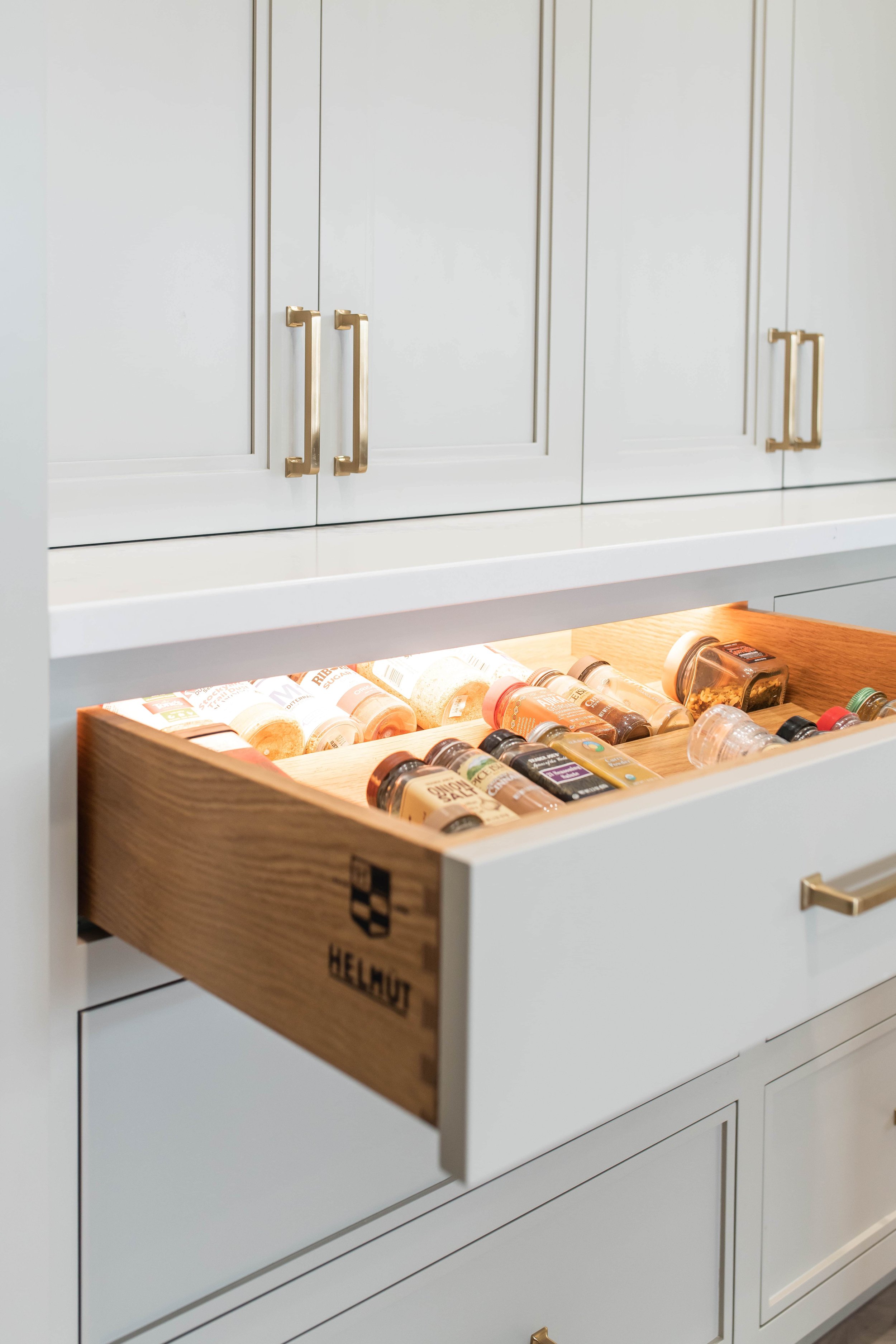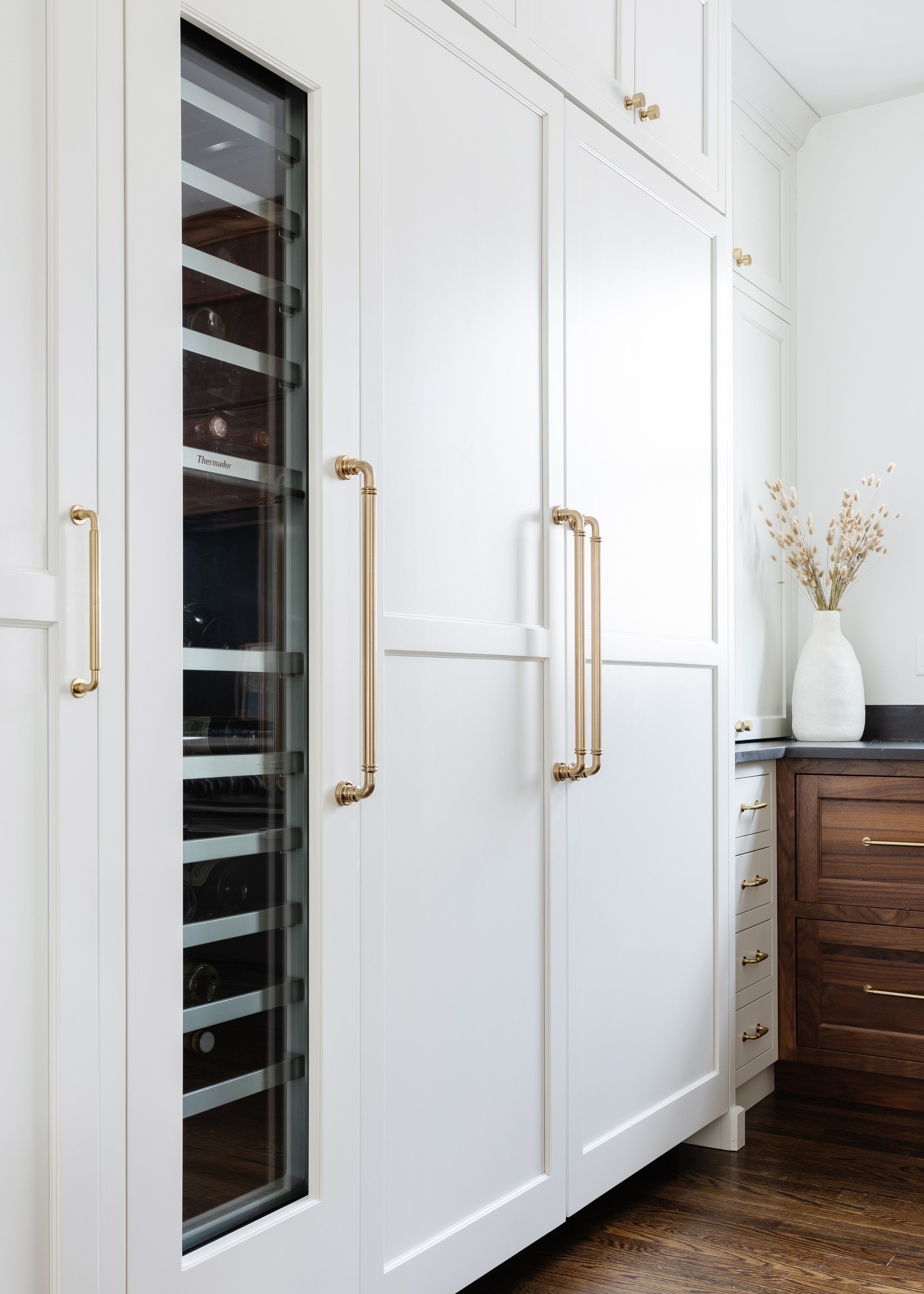Drawers, Shelves, or Trays: Which Is Right for Your Kitchen?
In the world of kitchen design, the choice between drawers, trays, or shelves is a pivotal one. Kitchen storage isn't just about stowing items away; it's about creating a space that enhances your cooking experience and brings joy to every meal prepared. It's a question that we at Helmut encounter frequently, which is why we wanted to delve into the merits of drawers, shelves, and trays, guiding you to the perfect choice for your home.
Understanding Kitchen Dynamics
At the core of every kitchen's functionality is its storage capability. The way we organize ingredients, utensils, and appliances significantly impacts our workflow and efficiency. A well-thought-out storage system not only streamlines your cooking process but also brings a sense of calm and order to your home. This is why your storage choice is so important. Let’s take a look at each of these three in detail.
The Allure of Drawers
The modern kitchen's ally, drawers, offer an unmatched blend of convenience and organization. Drawers offer a sleek and modern solution to kitchen storage, providing hidden spaces that keep utensils and cutlery within reach yet out of sight. Segmented storage options allow for meticulous organization, ensuring everything has its place—from spatulas to spice jars.
By incorporating custom dividers and modular organizers, drawers can be personalized to suit any storage need, making them an essential component of a clutter-free kitchen.
The accessibility and space optimization provided by drawers make them a favorite in contemporary kitchen designs.
Shelves: Traditional Elegance
There's a timeless charm to open shelving that invites a display of beautiful kitchenware and cherished collections. Shelves not only serve the practical purpose of easy access but also act as a stage for your personal style to shine through. The visual appeal and convenience of shelves can transform the kitchen into a space that's both functional and inviting.
Open shelving introduces a dimension of openness and accessibility to the kitchen, inviting natural light to illuminate displayed items and creating an illusion of spaciousness. While open shelving requires a mindful approach to organization, its ability to enhance the kitchen's visual appeal is unparalleled.
Trays: Tapping into Versatility
Trays are the unsung heroes of kitchen organization, offering unparalleled versatility. They can serve as compact storage solutions, mobile serving options, and even decorative elements. Nesting trays, in particular, are excellent for conserving space while providing the flexibility to expand your storage needs on demand.
Trays come in various forms, from adjustable cutlery trays to specialized inserts for spices and utensils, ensuring each item has a designated spot. This meticulous organization extends beyond convenience, promoting a sense of order that resonates throughout the kitchen.
Ergonomics and Accessibility
The right storage solutions can greatly enhance the ergonomic function of your kitchen. Drawers pull out to reveal contents at a glance, reducing the need to reach or bend. Shelves positioned at the right height make essential items easily accessible. Trays offer portable convenience, allowing you to bring what you need directly to your workspace.
Customization Options
One size does not fit all in kitchen organization. Custom drawer dividers, adjustable shelving, and personalized tray configurations allow you to tailor your storage to suit your unique needs. Whether it's accommodating large pots or organizing a spice collection, customization is key to a functional kitchen.
Space Utilization in Compact Kitchens
In smaller kitchens, every inch counts. Compact drawers and vertical shelving can maximize storage without sacrificing floor space. Creative solutions, such as under-shelf trays or over-the-door racks, can unlock new storage potentials in even the tiniest of kitchens.
Aesthetics and Design Harmony
Integrating different storage options doesn't mean compromising on style. A harmonious kitchen design balances functionality with aesthetics, choosing materials and finishes that complement the overall look. Whether you prefer the warmth of wood or the sleekness of metal, there's a way to make drawers, shelves, and trays work beautifully together.
Maintenance and Cleaning
Ease of maintenance is a crucial factor in choosing your kitchen storage. Drawers with smooth surfaces and removable dividers are easier to clean. Open shelves may require more regular dusting but also encourage a minimalist approach to kitchenware. Trays can be wiped down or washed separately, making them a practical choice for busy households.
Cost Considerations
Budget plays a significant role in selecting drawers, shelves, or trays. While custom solutions may come with a higher price tag, the investment in quality storage can enhance your kitchen's functionality and appeal. Consider the long-term value and durability of materials when making your choice.
When looking at cost amongst each of these options, typically drawers will be a higher cost. Trays will be the lowest costing options. While, shelves can vary depending on the quality of the shelves you are choosing. Custom shelving options with high quality materials will definitely cost more than other options, but will also last much longer than other options.
Expanded Expert Answers to Your FAQs
-
Custom drawers are tailored to fit not just your kitchen's dimensions but also your lifestyle. Whether you need deep drawers for heavy appliances or slim ones for utensils, customization ensures every item has its place. The adaptability of custom drawers supports a wide array of organizational accessories, making them a cornerstone of efficient kitchen design.
-
Trays maximize the utility of drawers by compartmentalizing space, allowing for the orderly storage of items based on frequency of use or category. This segmentation transforms drawers from mere storage spaces into highly organized units, streamlining the cooking process and enhancing your kitchen's overall functionality.
-
Open shelves are a hallmark of minimalist design, embodying the principles of simplicity and functionality. By carefully curating items for display, you can maintain a minimalist aesthetic while ensuring that everything remains accessible. The visual lightness of open shelves complements the minimalist ethos, making them a smart choice for those seeking to balance form and function.
-
Your choice should hinge on the specific needs of your kitchen and personal preferences. Pull-out trays offer unparalleled access to hard-to-reach items, making them ideal for storing heavy cookware. Static drawers, with their customizable layouts, are suited for organizing smaller items. Assessing how you use your kitchen will guide you to the most practical and satisfying choice. Refer to our self-guided questions below to help you determine which is best for you.
-
The key to this balance is thoughtful design that considers both the visual elements of storage solutions and their practical impact on your daily life. Choose materials and finishes that reflect your aesthetic, while opting for organizational systems that enhance your kitchen's functionality. Integrating storage solutions that serve both needs ensures a kitchen that is as beautiful as it is practical.
11 Questions You Can Ask to Help You Choose Between Drawers, Trays and Shelves
1. What types of items are you planning to store?
Drawers: Small to medium items that benefit from being out of sight but organized, such as utensils, spices, and linens.
Trays: Items that are used frequently and might need to be moved around often, such as cutlery for setting the table or baking supplies for gathering ingredients.
Shelves: Larger items or items you want to display, like dishes, glasses, and cookbooks.
2. How often do you use these items?
Drawers: Frequently used items that you want to keep organized and easily accessible without cluttering your countertop.
Trays: Very frequently used items that can be easily transported or items that need to be accessible from different locations.
Shelves: Items that you use often and don't mind being in open view, or items used less frequently that can be stored higher up.
3. Do you prefer your items hidden away or displayed?
Drawers: Prefer items hidden away for a clean and uncluttered look.
Trays: No strong preference; trays can be used in both hidden and displayed settings depending on their placement.
Shelves: Prefer items displayed or don’t mind items being visible for ease of access.
4. How much space do you have in your kitchen?
Drawers: Suitable for both small and large kitchens but ideal when wanting to maximize every inch of space efficiently.
Trays: Flexible for any space; can be used to organize within drawers or on shelves, making them adaptable to changing needs and spaces.
Shelves: Best for kitchens with available wall space for mounting or when wanting to give the kitchen a more open feel.
5. Are you looking for a solution to improve organization or efficiency?
Drawers: Improve organization by keeping items neatly sorted and out of sight.
Trays: Improve efficiency by grouping items together that will be used together, making setup and cleanup faster.
Shelves: Improve organization for items that are fine to be stored openly and can benefit from the ease of visual access.
6. What is your budget for kitchen storage solutions?
Drawers: Higher budget, as drawers can be more costly due to the hardware and installation required.
Trays: Lower budget, as trays are generally less expensive and can be added to existing drawers or shelves.
Shelves: Variable budget; simple shelving can be cost-effective, but custom or designer options can increase the cost.
7. Do you have specific aesthetic preferences for your kitchen?
Drawers: Prefer a modern, minimalist look with clean lines and surfaces.
Trays: Flexible; can be selected to match any aesthetic depending on material and design.
Shelves: Prefer a more traditional, rustic, or eclectic look that allows for decorative item display.
8. How important is ease of cleaning to you?
Drawers: Prefer not to see clutter; drawers can hide away mess but require occasional cleaning out.
Trays: Easy to clean individually and can help keep drawers or shelves organized, making overall cleaning simpler.
Shelves: Prefer ease of wiping down surfaces without moving many items; however, items on shelves may need to be dusted frequently.
9. Are ergonomics a consideration in your kitchen design?
Drawers: Yes, particularly for heavy items or if bending and reaching are concerns; items can be pulled out to waist height.
Trays: Yes, if used to minimize the need for reaching or lifting; can be easily carried to work areas.
Shelves: Less so, unless items are stored at an easily reachable height; higher or lower shelves may require bending or reaching.
10. Do you need to customize your storage space over time?
Drawers: Prefer a more permanent solution but with options for customizable organizers and dividers.
Trays: Prefer maximum flexibility; trays can be rearranged or repurposed as needs change.
Shelves: Prefer some flexibility; adjustable shelves can accommodate items of varying heights.
11. Are you considering the environmental impact of your storage options?
Drawers: Looking for durable, long-lasting materials that might have a higher initial environmental impact but less waste over time.
Trays: Prefer items made from sustainable materials; trays can be made from bamboo, recycled plastic, or other eco-friendly materials.
Shelves: Interested in materials and production processes that are sustainable; open to reclaimed wood or recycled metal shelves.
By answering these questions, you can narrow down which kitchen storage options—drawers, trays, or shelves—best suit your needs, preferences, and lifestyle.
Conclusion
Choosing between drawers, shelves, or trays for your kitchen boils down to understanding your needs, preferences, and the unique dynamics of your space. By considering ergonomics, aesthetics, and functionality, you can create a kitchen that's not just organized, but a joy to cook in. Remember, the best kitchen is one that reflects your lifestyle and brings out the best in your culinary adventures.
If you are needing help with your next kitchen upgrade, our designers are able to help chime in on what is right for your specific kitchen needs and will be able to help you understand how each of these options would work for your specific cabinetry setup. Request a free custom quote today.






